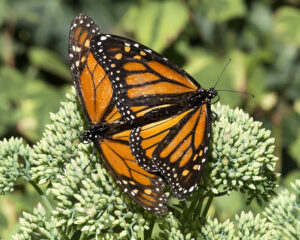Summer Lovin' Monarchs in September
September 10, 2024

By STEPHANIE JORDAN
For fans of monarch butterflies, Oklahoma is a fun place to be right now. The reproductive monarchs arrived several weeks late and eggs are just starting to appear for the ‘bonus generation’ that will join the larger migration as they become adults. Towards the end of September, we tend to get the major influx of the peak migration, which will either mean we get to see lots of beautiful monarchs visiting our gardens, or that we need binoculars and a comfy chair to watch them taking advantage of south blowing currents hundreds of feet above us.
THE BREEDERS
 A few weeks later than usual, but the reproductive monarchs are finally here. Not to be confused with the sexually immature, traveler monarchs who will show up in larger numbers toward the end of the month, these summer hotties are looking for love and milkweed. The delayed arrival of these sexually active monarchs will undoubtedly contribute to the perception that healthy milkweed confuses traveler monarchs and kicks them into sexual reproduction. These are two very different populations, so PLEASE DO NOT CUT BACK YOUR MILKWEED RIGHT NOW – IT IS NEEDED TO SUPPORT THIS GENERATION.
A few weeks later than usual, but the reproductive monarchs are finally here. Not to be confused with the sexually immature, traveler monarchs who will show up in larger numbers toward the end of the month, these summer hotties are looking for love and milkweed. The delayed arrival of these sexually active monarchs will undoubtedly contribute to the perception that healthy milkweed confuses traveler monarchs and kicks them into sexual reproduction. These are two very different populations, so PLEASE DO NOT CUT BACK YOUR MILKWEED RIGHT NOW – IT IS NEEDED TO SUPPORT THIS GENERATION.
The self-reporting of citizen scientists has been helpful in coming to understand the phenomenon of a bonus, end of summer generation of monarch eggs that are deposited in Oklahoma and Texas. As these develop into sexually immature, traveler butterflies, they will join the larger migration headed to Mexico for the winter, and reach full sexual maturity the following spring when temperature and daylength cues cause a chemical shift in their brains. Your reporting of egg and larval activity on milkweed at this time is very helpful to the scientific community.
WEATHER: SURFERS AND ROOSTERS

This time of year, monarchs take advantage of cold fronts as though they are little south-moving Ubers that give them a break from all that wing flapping. There have been a couple of small cold fronts in the last 10 days or so that has brought in influxes of the breeding monarchs that have suddenly popped up all over the state.
Closer to peak migration, there will be big groups of monarchs surfing on much bigger cold fronts – some big enough to show up on weather radars! So, when we see a forecast that has the good ole SW to NE Oklahoma wind shifting to blow from the north, we might expect the show to begin soon. But will it? Maybe. Maybe not. When coasting on these fronts, monarchs tend to be high - even hundreds of feet
up in the sky, requiring binoculars to watch them zoom by, unless the wind shifts back out of the south, making flight difficult.

Monarchs migrate by day as single butterflies, and don’t fly at night. They come down in the afternoon, feed on nectar, and rest in trees overnight. They are not sleeping, per se, but in a sort of suspended animation. Sometimes there is just a single monarch here and there, sometimes there are several gathered closely, sometimes there are hundreds or even thousands. A cluster of resting monarchs is called a roost, and if you are lucky enough to encounter one, you won’t soon forget it.
Where to look? While roosting sites may form at the intersection of weather events (winds from the south, or sudden temperature drops) there are some interesting features that can contribute to site selection. Factors such as a good, nearby nectar source; shelter from the wind, such as a valley or riparian area; a stream; individual tree shape and/or a cluster of trees in an area with fewer trees. These ingredients make for an attractive potential roost site. Those of you familiar with the Myriad Botanical Gardens in OKC, might recognize several of these features that make this a popular site for annual monarch roosts.
Watch Okies for Monarchs social pages for happenings and sightings through peak migration!

